Neurofeedback for Posttraumatic Stress Disorder
Neurofeedback for PTSD
Neurofeedback is a brainwave training technique that is a valuable adjunct in the PTSD counsellor’s tool box. Neurofeedback offers a way to integrate traumatic memories of PTSD which can be combined with other therapies such as CBT. Clients in various dissociative states may listen but as all counsellors know, don’t always really hear the message. However, Neurofeedback can help reconnect the brain based fragmented sense of self that is caused by their emotional numbing. Then the traumatised brain is better able to listen and attend to the therapeutic message. The survival-based response of the traumatised brain is calmed so that the rationality of the prefrontal cortex can mature and downgrade the fear network that is triggered by flashbacks and nightmares.
Neurofeedback is part of the same stable as other physiological therapies such as Biofeedback and Heart Rate variability but can lead to more healing states. The traumatized brain is able to relax into mindfulness and meditative states allowing deeper understanding and communication in the therapeutic relationship. Often a PTSD client is in a state of psychological paralysis, unable to talk about or even remember accurately the traumatizing events, since their limbic systems are in hypervigilant mode which freezes up the speech areas in the left frontal lobe as well as memory consolidation. Talking therapies can take months or more to disarm the emotional “survival” system that is over activating the senses: the sight, sound or smells of often repressed episodic memories associated with past trauma while Neurofeedback has been shown to truncate the length of therapy.
PTSD and the Brain
Dr. Frank Ochberg discusses what happens to the brain after a traumatic event.
Neurofeedback turns PTSD into
Past Traumas Simply Dissipate (PTSD)
Neurofeedback for PTSD
This Video is from EEGInfo in the US and is about how Neurofeedback can help with PTSD.
Neurofeedback for Posttraumatic stress disorder (PTSD) Workshop
with Dr Beverley Steffert and Dr Tony Steffert
A one day extension workshop in Neurofeedback for PTSD, in Camden, London.
This workshop is intended for people who work with PTSD and have either taken a general beginner’s Neurofeedback workshop or who have already had some experience with Neurofeedback and want to work with PTSD.
It builds on our 4 day beginner’s neurofeedback workshop we run in Autumn and covers the more advanced Neurofeedback protocol called ‘Alpha/Theta’.
The workshop will cover the theory and practice of Neurofeedback for PTSD, with Lectures, Demonstrations, and Hands-On practise.
In this one day workshop participants will learn to:
• Recognise the physiological basis of trauma, from disordered breathing, heart rate variability and the EEG patterns of over-arousal.
• To run a neurofeedback session from placement of electrodes to monitoring the changes in brainwaves over the sessions.
• To use a special type of Neurofeedback (Alpha/theta training) which can, when used in the therapeutic situation, resolve long entrenched emotional issues and help to build a bridge to the true self through better connectivity of the default mode networks.
Dates:
We currently do not have a date booked, so please contact us if you are interested in attending this workshop.
We meet at 9:30 am to start for 10 am and we will go till around 5:30 pm.
Cost:
The cost of the 1 day workshop will be: £150
British Neuroscience Association Members or Society of Applied Neuroscience: £140
Student registration £100
The programme:
We will meet around 9:30 am start for 10am and go till 5:30/6pm, (We understand that people can have a long way to travel, so we try not to put the important stuff at the beginning and end of the day)
10 am The Psychopathogenesis of PTSD.
• Acute and chronic stress
• Neural circuitry of the stress system; the changes and losses in the brain due to trauma
• The evolution of trauma – adaptive and maladaptive responses.
• Maturation and neurogenesis
• Dissociative responses and EEG
Overview of Neurofeedback training, recognising EEG patterns of trauma, and how these can be trained towards normality.
Integrating the counsellor’s mode of treatment with Neurofeedback.
How the effects of early relational trauma alter personality, resilience and reaction to later trauma which may alter neurofeedback protocols
11 am Break
Demonstration of a session Neurofeedback and Heart Rate Variability
12.30 am Lunch
1.30 pm Hands-on Neurofeedback practice sessions to run your own session
All participants will have a neurofeedback system provided to work on. We now introduce Alpha/Theta training, which induces deep relaxation and a semi-hypnogogic state and helps dissociative states become more conscious.
2.30 pm Break
3 pm Case Studies of PTSD and Neurofeedback
Neuroplasticity: Review of the brain circuits involved in PTSD and how Neurofeedback can normalise them.
4.30 pm Discussion of Neurofeedback equipment
Major systems will be displayed
Review and Q and A session
Getting on the same wavelength is a key concept in Counselling, where a client feels understood and accepted and able to develop in therapeutic ways. The counsellor must convey an “unconditional positive regard” through the core skills of active listening, genuineness, empathy, openness and matching and mirroring body language, gesture, tone of voice and forms of speech. This creates a congruence reflecting an underlying attunement of physiology, from respiration rate, blood flow and heart rhythm to brainwaves. This internal alignment can be enhanced with the use of Heart Rate Variability, pulse oximeters and breathing Apps all of which will be explained and demonstrated. These are all easy to use and understand, requiring only finger sensors to measure physiology. This session will explain the role of the vagal system in emotions and health and how these elements of attunement can be measured.
Location:
The Open University
London Regal Office
1-11 Hawley Crescent
London, NW1 8NP
Contact:
Get In Contact With Us
[contact-form-7 id=”147″ title=”Contact form 1″]
Tony Steffert
47 c Christchurch Av.
London, NW6 7BB
W: qeeg.co.uk
E: tony@qeeg.co.uk
P: + 44 (0) 7966 484 289

References:
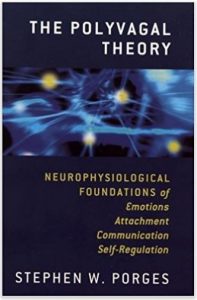
The Polyvagal Theory by Steve Porges
A collection of groundbreaking research by a leading figure in neuroscience.
This book compiles, for the first time, Stephen W. Porges’s decades of research. A leading expert in developmental psychophysiology and developmental behavioral neuroscience, Porges is the mind behind the groundbreaking Polyvagal Theory, which has startling implications for the treatment of anxiety, depression, trauma, and autism. Adopted by clinicians around the world, the Polyvagal Theory has provided exciting new insights into the way our autonomic nervous system unconsciously mediates social engagement, trust, and intimacy.
Recommended reading:
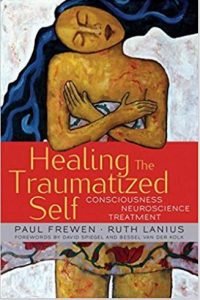
Review:
“Breaking new ground, if not creating an entirely new research and clinical domain, this book startles with its intelligence and breadth. Frewen and Lanius call upon over a decade of functional MRI research and detailed clinical interviews to define what they refer to as ‘trauma-related altered states of consciousness’ (TRASC). The ideas are new, the data are very strong, and the grounding in the real-world experience of suffering people is refreshing. This is a whole new step forward in understanding and assisting those with dissociative difficulties.” — John Briere, PhD, Associate Professor of Psychiatry and Psychology, University of Southern California; Director, USC Adolescent Trauma Training Center, National Child Traumatic Stress Network “This is a landmark book in the history of psychotraumatology. Frewen and Lanius have created a new intellectual blueprint for understanding dissociation. Their book is unique in providing a detailed integration of the latest neuroscientific findings with the experience of what it is like to be traumatized. It is a treasure trove of ideas for anyone pursuing the study or healing of the traumatized self.” — Chris R. Brewin, Professor of Clinical Psychology, University College London “This book reaches into the depth of PTSD-the invisible domain of troubled brains that can captivate the mental apparatus. Healing the Traumatzied Self provides clear insights to help people return to the joys of human companionship. It is a must read for all who wish to understand the neurodynamics of broken minds and pathways to healing.” — Jaak Panksepp, Professor of Neuroscience and Baily Endowed Chair of Animal Well Being Science, Washington State University, Pullman, WA “In this scholarly, highly focused, yet accessible and readable volume, Frewen and Lanius tackle the characterization, meaning, and neurophenomenological basis for dissociation. The deep clinical insights coupled with state of the art neuroimaging data permit an in-depth analysis of dissociation in its many forms, and its relationship to traumatization, perception, and brain/mind/body connections. This work considerably advances our knowledge of dissociation and lays out a pathway for successful therapeutic interventions for highly traumatized individuals.” — Rachel Yehuda, PhD, Director of the Traumatic Stress Studies Division at Icahn School of Medicine; Mental Health Patient Care Center Director at the James J. Peters Veterans Affairs Medical Center
About the Author
Paul Frewen, PhD, teaches at the University of Western Ontario and lives in London, Ontario. Ruth Lanius, MD, PhD, teaches at the University of Western Ontario and lives in London, Ontario
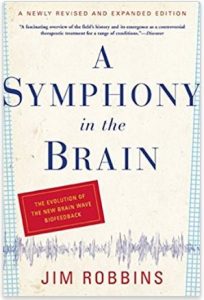
Amazon Review
Can you fix your own neurological problems without resorting to drugs? Science writer Jim Robbins suggests that some such conditions–like epilepsy, autism and depression–could yield to a recently developed technique called neurofeedback. His book A Symphony in the Brain describes the process, its evolution from the 1970s fad of biofeedback, its practitioners, and some of its success stories. Using computers to quickly provide information on real-time EEG, practitioners train patients to control global or local brain states–or so the theory goes. Unfortunately for its proponents, there are still no rigorous research data showing conclusive results; Robbins makes a good case that the lack of research is due more to scientific turf battles and a drug-dependent medical establishment than any fault of neurofeedback. Some of the case studies he explores, of children and adults brought out of comas or trained to reduce their epileptic seizure frequency, suggest that we ought to look more deeply and rigorously into the technique. Whether or not it works can only be determined by controlled studies which may be forthcoming; in the meantime Robbins provides contact lists and additional research information for interested readers, as well as the inspiration to pursue a potentially life-saving treatment. –Rob Lightner
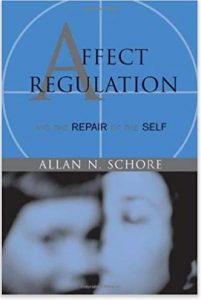
In 1994 Allan Schore published his groundbreaking book, Affect Regulation and the Origin of the Self, in which he integrated a large number of experimental and clinical studies from both the psychological and biological disciplines in order to construct an overarching model of social and emotional development. Since then he has expanded his regulation theory in more than two dozen articles and essays covering multiple disciplines, including neuroscience, psychiatry, psychoanalysis, developmental psychology, attachment, and trauma. Affect Regulation and the Repair of the Self contains chapters on neuropsychoanalysis and developmentally oriented psychotherapy. It is absolutely essential reading for all clinicians, researchers, and general readers interested in normal and abnormal human development.
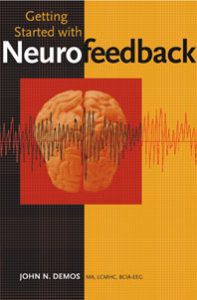
Neurofeedback training combines the principles of complementary medicine with the power of electronics. It is a comprehensive system that promotes growth change at the cellular level of the brain and empowers the client to use his or her mind as a tool for personal healing.Until now, there has not been a single comprehensive yet easy-to-understand guide for clinicians interested in adding neurotherapy to their practice. Getting Started with Neurofeedback is a step-by-step guide for professional health care providers who wish to begin with neurotherapy, as well as experienced clinicians who are looking for a concise treatment guide.This book answers essential questions such as: How does neurotherapy work?, What is the rationale for treatment? When is neurotherapy the treatment of choice? Why should I add it to my already existing healthcare practice? The author also answers questions important to establishing a successful practice such as: What kind of training should clinicians get? What kind of equipment should clinicians buy? How can clinicians add neurofeedback to their existing practice?The first part of the book introduces the reader to the world of neurofeedback, its history and scientific basis. Case studies help clinicians apply what they are learning to their existing practice. Demos takes the mystery out of the assessment process and charts and examples of topographical brain maps (in full color) serve as teaching aids. Later in the book, advanced techniques are explained and demonstrated by additional case studies. The reader is shown how to use biofeedback for the body to augment neurofeedback training as well as being taught to work with the body and acquire a basic knowledge of complementary medicine.The book concludes by offering clinicians practical suggestions on marketing their expanded practice, purchasing equipment, finding appropriate training and supervision, and keeping up with the ever-growing profession of neurofeedback. Research and theory unite to demonstrate the clinical underpinnings for this exciting new modality.
Bibliography:
Tuning pathological brain oscillations with neurofeedback: a systems neuroscience framework.
Ros T, J Baars B, Lanius RA, Vuilleumier P.
Front Hum Neurosci. 2014 Dec 18;8:1008. doi: 10.3389/fnhum.2014.01008. eCollection 2014.
Abstract:
Neurofeedback (NFB) is emerging as a promising technique that enables self-regulation of ongoing brain oscillations. However, despite a rise in empirical evidence attesting to its clinical benefits, a solid theoretical basis is still lacking on the manner in which NFB is able to achieve these outcomes. The present work attempts to bring together various concepts from neurobiology, engineering, and dynamical systems so as to propose a contemporary theoretical framework for the mechanistic effects of NFB. The objective is to provide a firmly neurophysiological account of NFB, which goes beyond traditional behaviorist interpretations that attempt to explain psychological processes solely from a descriptive standpoint whilst treating the brain as a “black box”. To this end, we interlink evidence from experimental findings that encompass a broad range of intrinsic brain phenomena: starting from “bottom-up” mechanisms of neural synchronization, followed by “top-down” regulation of internal brain states, moving to dynamical systems plus control-theoretic principles, and concluding with activity-dependent as well as homeostatic forms of brain plasticity. In support of our framework, we examine the effects of NFB in several brain disorders, including attention-deficit hyperactivity (ADHD) and post-traumatic stress disorder (PTSD). In sum, it is argued that pathological oscillations emerge from an abnormal formation of brain-state attractor landscape(s). The central thesis put forward is that NFB tunes brain oscillations toward a homeostatic set-point which affords an optimal balance between network flexibility and stability (i.e., self-organised criticality (SOC)).
Plastic modulation of PTSD resting-state networks and subjective wellbeing by EEG neurofeedback.
Kluetsch RC, Ros T, Théberge J, Frewen PA, Calhoun VD, Schmahl C, Jetly R, Lanius RA.
Acta Psychiatr Scand. 2014 Aug;130(2):123-36. doi: 10.1111/acps.12229. Epub 2013 Nov 25.
Abstract:
OBJECTIVE: Electroencephalographic (EEG) neurofeedback training has been shown to produce plastic modulations in salience network and default mode network functional connectivity in healthy individuals. In this study, we investigated whether a single session of neurofeedback training aimed at the voluntary reduction of alpha rhythm (8-12 Hz) amplitude would be related to differences in EEG network oscillations, functional MRI (fMRI) connectivity, and subjective measures of state anxiety and arousal in a group of individuals with post-traumatic stress disorder (PTSD).
METHOD: Twenty-one individuals with PTSD related to childhood abuse underwent 30 min of EEG neurofeedback training preceded and followed by a resting-state fMRI scan.
RESULTS: Alpha desynchronizing neurofeedback was associated with decreased alpha amplitude during training, followed by a significant increase (‘rebound’) in resting-state alpha synchronization. This rebound was linked to increased calmness, greater salience network connectivity with the right insula, and enhanced default mode network connectivity with bilateral posterior cingulate, right middle frontal gyrus, and left medial prefrontal cortex.
CONCLUSION: Our study represents a first step in elucidating the potential neurobehavioural mechanisms mediating the effects of neurofeedback treatment on regulatory systems in PTSD. Moreover, it documents for the first time a spontaneous EEG ‘rebound’ after neurofeedback, pointing to homeostatic/compensatory mechanisms operating in the brain.
Distinct intrinsic network connectivity patterns of post-traumatic stress disorder symptom clusters.
Tursich M, Ros T, Frewen PA, Kluetsch RC, Calhoun VD, Lanius RA.
Acta Psychiatr Scand. 2015 Jan 9. doi: 10.1111/acps.12387
Abstract:
OBJECTIVE: Post-traumatic stress disorder (PTSD) is considered a multidimensional disorder, with distinct symptom clusters including re-experiencing, avoidance/numbing, hyperarousal, and most recently depersonalization/derealization. However, the extent of differing intrinsic network connectivity underlying these symptoms has not been fully investigated. We therefore investigated the degree of association between resting connectivity of the salience (SN), default mode (DMN), and central executive (CEN) networks and PTSD symptom severity.
METHOD: Using resting-state functional MRI data from PTSD participants (n = 21), we conducted multivariate analyses to test whether connectivity of extracted independent components varied as a function of re-experiencing, avoidance/numbing, hyperarousal, and depersonalization/derealization.
RESULTS: Hyperarousal symptoms were associated with reduced connectivity of posterior insula/superior temporal gyrus within SN [peak Montréal Neurological Institute (MNI): -44, -8, 0, t = -4.2512, k = 40]. Depersonalization/derealization severity was associated with decreased connectivity of perigenual anterior cingulate/ventromedial prefrontal cortex within ventral anterior DMN (peak MNI: 8, 40, -4; t = -3.8501; k = 15) and altered synchrony between two DMN components and between DMN and CEN.
CONCLUSION: Our results are consistent with prior research showing intrinsic network disruptions in PTSD and imply heterogeneous connectivity patterns underlying PTSD symptom dimensions. These findings suggest possible biomarkers for PTSD and its dissociative subtype.
Alpha-theta brainwave neurofeedback training: an effective treatment for male and female alcoholics with depressive symptoms.
Saxby E, Peniston EG.
J Clin Psychol. 1995 Sep;51(5):685-93.
Abstract
This was an experimental study of 14 alcoholic outpatients using the Peniston and Kulkosky (1989, 1991) brainwave treatment protocol for alcohol abuse. After temperature biofeedback pretraining, experimental subjects completed 20 40-minute sessions of alpha-theta brainwave neurofeedback training (BWNT). Experimentally treated alcoholics with depressive syndrome showed sharp reductions in self-assessed depression (Beck’s Depression Inventory). On the Millon Clinical Multiaxial Inventory-I, the experimental subjects showed significant decreases on the BR scores: schizoid, avoidant, dependent, histrionic, passive-aggression, schizotypal, borderline, anxiety, somatoform, hypomanic, dysthmic, alcohol abuse, drug abuse, psychotic thinking, and psychotic depression. Twenty-one-month follow-up data indicated sustained prevention of relapse in alcoholics who completed BWNT.
Alpha-theta brainwave training and beta-endorphin levels in alcoholics.
Peniston EG, Kulkosky PJ.
Alcohol Clin Exp Res. 1989 Apr;13(2):271-9.
Abstract
An alpha-theta brainwave biofeedfack training program was applied as a novel treatment technique for chronic alcoholics. Following a temperature biofeedback pretraining phase, experimental subjects completed 15 30-min sessions of alpha-theta biofeedback training. Compared to a nonalcoholic control group and a traditionally treated alcoholic control group, alcoholics receiving brainwave training (BWT) showed significant increases in percentages of EEG record in alpha and theta rhythms, and increased alpha rhythm amplitudes. Alcoholics receiving BWT showed a gradual increase in alpha and theta brain rhythms across the 15 experimental sessions. These experimentally treated alcoholics showed sharp reductions in self-assessed depression (Beck’s Depression Inventory) compared to the control groups. Alcoholics receiving standard medical treatment (abstinence, group psychotherapy, antidepressants) showed a significant elevation in serum beta-endorphin levels at the conclusion of the experiment. This neuropeptide is an index of stress and a stimulant of caloric (e.g., ethanol) intake. Application of brainwave treatment, a relaxation therapy, appears to counteract the increase in circulating beta-endorphin levels seen in the control group of alcoholics. 13-month follow-up data indicate sustained prevention of relapse in alcoholics that completed alpha-theta brainwave training.
Alpha-Theta Brainwave Neuro-Feedback for Vietnam Veterans with Combat Related Post-Traumatic Stress Disorder
Peniston EG, Kulkosky PJ.
Medical PsychorIherapy 1991, Volume 4, pp. 47-60
Abstract
An experimental group of 20 male Vietnam combat veterans with a diagnosis of Post Traumatic Stress Disorder (PTSD) and alcohol abuse were treated with alpha-theta Brainwave Neuro-feedhack Therapy (BWNT). A four channel EEG, video screen and …
EEG alpha-theta brainwave synchronization in Vietnam theater veterans with combat-related post-traumatic stress disorder and alcohol abuse
EG Peniston, DA Marrinan, WA Deming, PJ Kulkosky
Advances in Medical Psychotherapy 6.7 (1993): 37-50.
Alcoholic personality and alpha-theta brainwave training
EG Peniston, PJ Kulkosky
Medical Psychotherapy, 3, 37-55. 1990
EEG brainwave training as a bio-behavior intervention for Vietnam combat-related PTSD.
Peniston EG
The Medical Psychotherapist. 1990, 6(2), Spring.
Regarding the database for the Peniston alpha-theta EEG biofeedback protocol.
Graap K, Freides D.
Appl Psychophysiol Biofeedback. 1998 Dec;23(4):265-72; 273-5.
Abstract:
Five papers by Peniston and colleagues, which constitute the basic literature for alpha-theta EEG biofeedback treatment for alcoholism and posttraumatic stress disorder, are reviewed. As a result, we raise three questions: (a) Are the samples studied independent? (b) What was the clinical status of the participants prior to treatment? (c) What treatment did the participants actually receive? In seeking answers to these questions we aim to strengthen the database for neurofeedback with specific procedural information so that claims of efficacy can be tested and accepted or rejected on an objective basis.
Neurofeedback with anxiety and affective disorders
D. Corydon Hammond
Child and Adolescent Psychiatric Clinics of North America Volume 14, Issue 1, January 2005, Pages 105–123
Abstract:
Compelling evidence exists for a neurophysiologic basis for obsessive-compulsive disorder (OCD). A large number of positron emission tomographic and single photon emission computed tomographic studies have found increased blood flow and metabolism in the mediofrontal, anterior cingulate, right frontal, or orbitofrontal areas [1–14], which implicates a cortico-striato-thalamocortical network. Functional abnormalities also have been documented in a large number of quantitative EEG (qEEG) studies [15–22] and evoked potential studies [23–27]. OCD seems to be somewhat heterogeneous, however, with at least two qEEG subtypes that have been found [17–21]. Prichep et al [20] and Kuskowski et al [15] found a group with excess alpha brain waves throughout most of the head, with frontal excess beta, whereas another subgroup has an excess of theta activity, particularly in frontal and posterior temporal areas. Clinical experience in conducting qEEG assessment with patients with OCD also has shown that excess beta activity is often found along the midline, in cortical areas approximately over the anterior cingulate.
Neurofeedback and Biofeedback for Mood and Anxiety Disorders: A Review of the Clinical Evidence and Guidelines
Ottawa (ON): Canadian Agency for Drugs and Technologies in Health; 2014 Aug.
Excerpt:
Patients with mental health disorders usually require pharmacological and/or psychological interventions such as cognitive-behavioral therapy. However, patients may not have easy access to such treatments, especially for those living in rural areas, or may not respond well to them. For example, approximately two-thirds of patients with major depressive disorder do not have adequate responses to pharmacological and/or psychological interventions. Biofeedback therapies are non-pharmacological treatments that use non-invasive electrical devices with bio-monitoring system and sensors to measure, amplify and feed back information primarily from nervous system processes such as respiration, heart rate, muscle tension, skin temperature, blood flow and blood pressure, to the individual being monitored, thus promoting awareness of these processes in an individual to assist with gaining voluntary control over body and mind. Neurofeedback is a specific form of biofeedback that monitors central nervous system activity via the measurement and regulation of brainwave activity from electrodes placed on the scalp. Training with neurofeedback aims to enable the individual to modify patterns of cortical activity and normalize brain activity. In general, biofeedback and neurofeedback are designed to increase patients’ coping skills for their current situations, and usually multiple sessions of treatment are required. This report was undertaken to update a previous summary of the evidence on the clinical effectiveness and safety of neurofeedback and biofeedback which was completed in 2012. In that report, findings from preliminary analyses raised the possibility that biofeedback and neurofeedback may have a potential for the treatment of post-traumatic stress disorder (PTSD), generalized anxiety disorder (GAD) or depression.
Neurofeedback: an integrative treatment of substance use disorders.
Ross SM.
Holist Nurs Pract. 2013 Jul-Aug;27(4):246-50. doi: 10.1097/HNP.0b013e3182971b7c.
Abstract:
Substance use disorders are exceedingly complicated as is the treatment. To increase positive outcomes, an understanding of all facets, bio/psycho/social/spiritual,economic, and interdisciplinary aspects, are essential to successful treatment. Neurofeedback has been applied successfully as an integrative treatment of SUDs for more than 30 years. Highlighted research that includes the Peniston Alpha-Theta protocol and Scott-Kaiser modifications of the Peniston protocol has shown that SUD treatment when combined with conventional treatment has the potential to improve measurable parameters and significantly increase positive outcomes.
Peak high-frequency HRV and peak alpha frequency higher in PTSD.
Wahbeh H, Oken BS.
Appl Psychophysiol Biofeedback. 2013 Mar;38(1):57-69. doi: 10.1007/s10484-012-9208-z.
Abstract:
Posttraumatic stress disorder (PTSD) is difficult to treat and current PTSD treatments are not effective for all people. Despite limited evidence for its efficacy, some clinicians have implemented biofeedback for PTSD treatment. As a first step in constructing an effective biofeedback treatment program, we assessed respiration, electroencephalography (EEG) and heart rate variability (HRV) as potential biofeedback parameters for a future clinical trial. This cross-sectional study included 86 veterans; 59 with and 27 without PTSD. Data were collected on EEG measures, HRV, and respiration rate during an attentive resting state. Measures were analyzed to assess sensitivity to PTSD status and the relationship to PTSD symptoms. Peak alpha frequency was higher in the PTSD group (F(1,84) = 6.14, p = 0.01). Peak high-frequency HRV was lower in the PTSD group (F(2,78) = 26.5, p < 0.00005) when adjusting for respiration rate. All other EEG and HRV measures and respiration were not different between groups. Peak high-frequency HRV and peak alpha frequency are sensitive to PTSD status and may be potential biofeedback parameters for future PTSD clinical trials.
